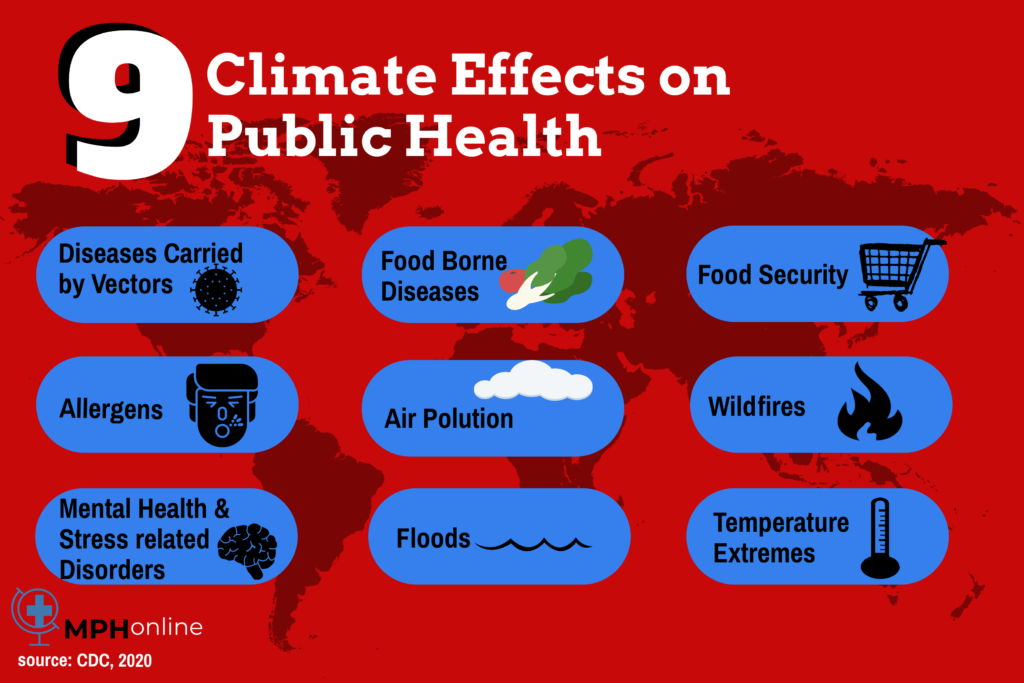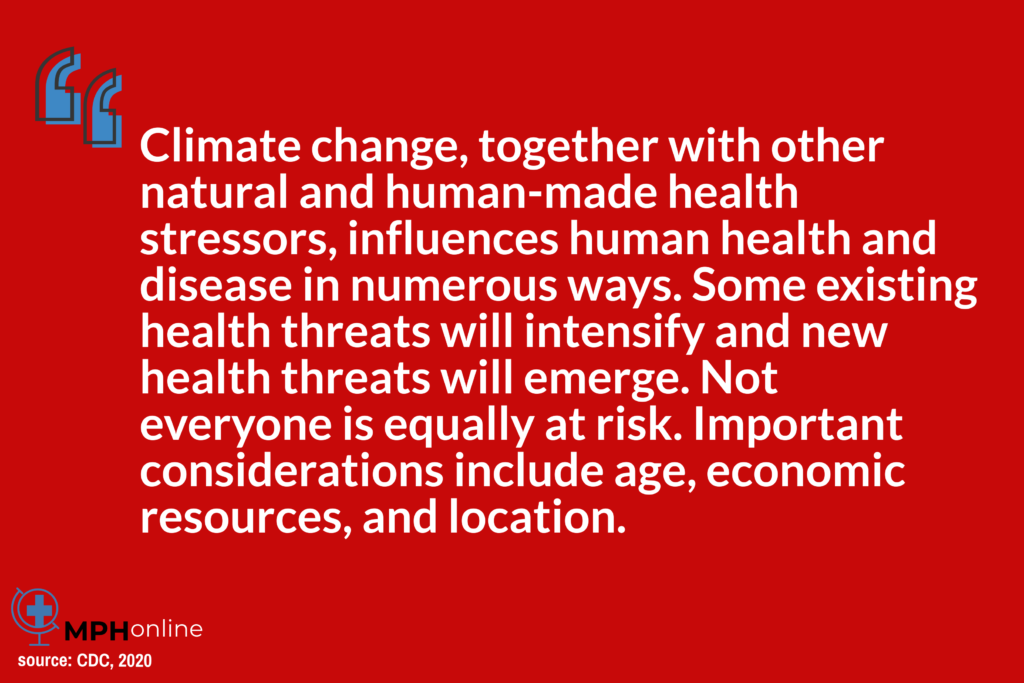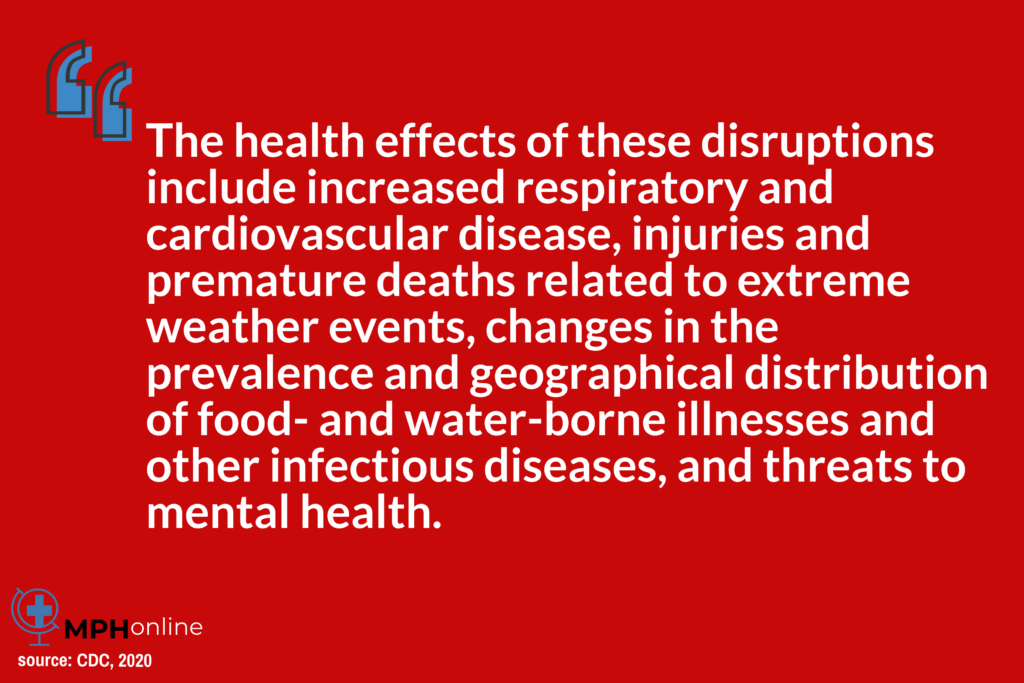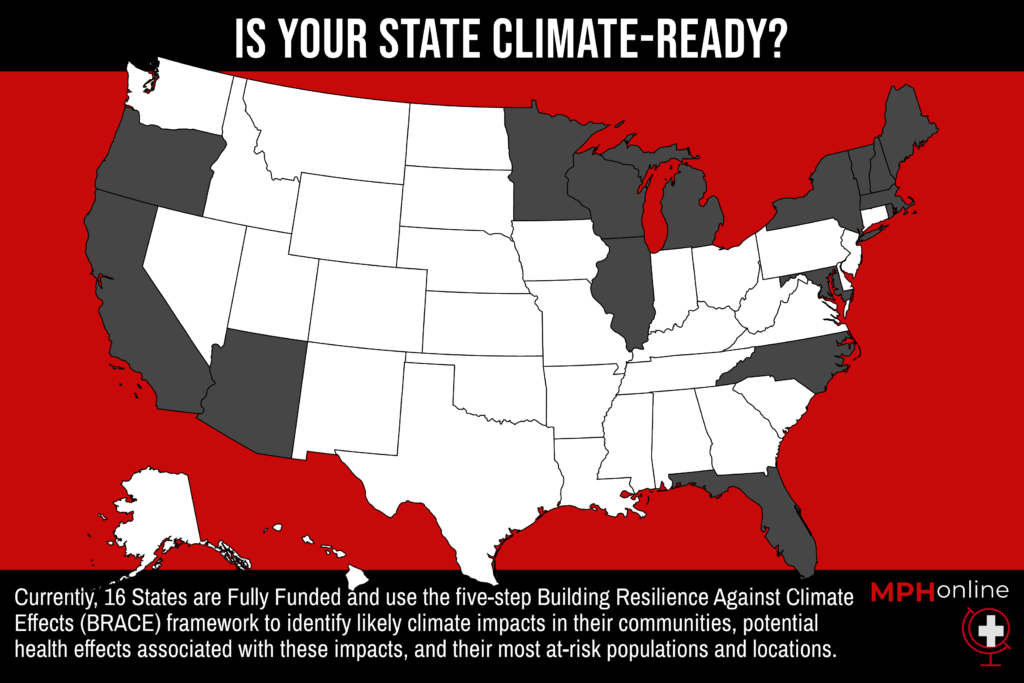How does climate change affect human health? Climate change and health have a very close relationship. While many people consider the environmental and economic issues that can stem from climate change, it’s just as important to consider the health effects of climate change, including climate change and implications on public health.
Why is Climate Change a Public Health Issue?
Climate change effects on humans health represent a large body of study encompassing several disciplines. Breaking the situation down into finer points helps to understand why climate change represents a public health issue.

Public health is a profession as well as a science that deals with the health of a population, rather than an individual. The public part can indicate a small group of people, the population of an entire city, the global population, or any select group. If some health concerns can affect multiple people, then that concern falls within the realm of public health.
Additionally, public health is about the science of health, meaning it can include preventive and proactive measures, not just reactionary ones. Public health is also the study of a group or population’s health. Because the effects of climate change on health can affect groups of people or whole regions, it can very well represent a public health issue.
What is Climate Change?
Many people have heard the terms climate change and global warming. While these two phrases can often seem synonymous, they’re two different things. This distinction can help to garner a greater understanding of the health effects of climate change as well as the specific concerns as they apply to global warming and public health.
Global warming is a term that indicates the increase in the planet’s overall surface temperature. By contrast, climate change represents the reactions and effects caused by that warming. In this way, global warming can represent the underlying cause of the problem while climate change can represent the overall symptoms. This is the connection between human health and global warming.
What Are the Symptoms of Climate Change?
Climate change symptoms include things like melting glaciers, rising sea levels, erratic weather, failed plant and vegetation cycles, and various other things. The causes of global warming and the ensuing results through climate change create a recipe for a host of health issues, and those climate change effects on humans health can have long-lasting effects at a regional and global level.
How Does Climate Change Affect Human Health?
How does climate change affect public health? Climate change effects on human health can vary and will depend on the type and specific effects of the changes. Climate change comes along with a plethora of potential health risks to individuals as well as groups of people.

The sheer amount of potential climate change effects on human health is what elevates climate change to a global public health emergency. Global climate change and public health situations can negatively affect overall public health, and climate change can help create, accelerate, or exacerbate those situations. For example, global warming and climate change contribute to all the following:
- Increased air pollution
- Increased allergens
- Decreased food supplies
- Flooding
- Wild temperature fluctuations
- Wildfires
- Decreased water quality
- Overall environmental ruin
All these things can negatively affect people on a physical and mental level. These are things that can lead too lung issues such as asthma, malnutrition, depression, an increase in sickness, and a tremendous number of other and related health issues.
Some other potential health effects of climate change can include increased risks of heat strokes, physical harm, disease-carrying insects, and the list never ends. In addition, climate change can allow diseases of all sorts to run rampant.
Even a change in climate in an area not accustomed to it can lead to an increase in mental ailments such as depression and anxiety. These ailments in turn can lead to an increase in other societal ills. For these reasons and more that climate change is a public health issue.
How Does Climate Change Contribute to the Spread of Disease?
Climate change effects on human health contribute to the spread of disease in several ways. This potential disease spread is only one part of the overall question of how is climate change affecting humans. However, it’s a concern everyone should take notice as disease is one of the larger health risks of climate change. There are two major ways climate change health impacts contribute to the spread of disease.
- Diseases by vector
- Water and foodborne diseases
In biology, a vector is anything that can carry and then transmit something infectious to another living thing. An easy example of this is the mosquito, but there are numerous potential vectors. Many of the organisms that work as vectors have predictable behaviors and patterns that allow for a modicum of control over how they might spread infectious pathogens.
Climate change alters those patterns and creates a high level of uncertainty, which can lead to a greater risk of infectious diseases spreading through human populations. Unexpected climate variations or gradual climate changes can lead to vectors becoming larger problems when they weren’t before.
Some disease-carrying insects may start to migrate to new areas or pick up resistance to old methods of dealing with them. Diseases can start to show up in places that never experienced them and places that have no protections or vaccines for them.
Examples of vector-borne diseases include Lyme disease, plague, malaria, and many more. Public health plays a huge role in spotting trends, preparing people, and helping people deal with the potential or the reality of these diseases coming their way because of climate change.
Infectious diseases require monitoring, tracking, study, and an understanding of what climate changes can lead to what vector-borne diseases arriving in new areas. In some cases, climate change can transform a disease to make it more viable to a new location.
This process can lead to the need for new techniques for dealing with a known disease. The vectors themselves can adapt or change because of global warming and changing climates. So, a public health crisis can occur that’s new and unprecedented.
For many of the same reasons, water and foodborne diseases can increase as well. Climate change affects temperatures, weather patterns, seasonal changes, and various other things in the land, air, and sea. These changes can lead to increased instances of disease transmissions.
Some diseases thrive at higher or lower temperatures. The amount of precipitation can also create avenues for diseases to propagate areas where they previously didn’t exist. For example, a diarrheal disease that prefers a warmer temperature and a little more precipitation may start to creep into groundwater and other areas as climate change slowly changes those areas. These same things can affect food as well.
Diseases may start to affect crops or livestock more as the climate change effects start to change to help the diseases spread. This all goes hand in hand with vector-borne diseases as well. More standing water in places not prone to it can lead to an increase in certain disease-carrying insects. Those insects can start to infect animals or crops, just as the contaminated water can. These are all issues that concern public health at every level and show the effects of climate change on health in general.
As the world has a high level of connectivity, there’s also a connection to how all issues concerning how climate change affects humans and the global population. Diseases that occur in unsuspecting places because of climate change can lead to those same diseases traveling to other parts of the world through shipping lanes and human travel.

How Does Climate Migration Affect Public Health?
Another concern of climate change, and the question of how is climate change affecting humans, comes with the idea of climate migration. When looking at how climate change affects humans, there’s a general understanding that people who experience large issues because of climate change will choose to move to other areas. These people are environmental or climate migrants.
Not only is climate migration a thing happening right now, but it’s also expected to increase exponentially in the near future. When thousands of people are on the move because of the effects of climate change on human health and living, there are also many public health concerns that go with the migration.
Why Climate Migration Happens
The impact of climate change on human health and environments will continue to make certain areas more inhospitable to the human beings that live in them. As people attempt to escape these impacts and the effects of climate change on health, they move further and further out. This leads to displacement and migration, which also leads to an increase in public health emergencies.
People often migrate because they’re looking for a better life or to escape harsh conditions. In this sense, climate change represents just another driving force that leads to migration and displacement. However, the effects of health and climate change can also make many of the more common issues that much worse, which leads to a growth in people seeking safety, sanctuary, and better circumstances.
Some factors that can lead to climate migration include climate change health impacts like:
- Drought
- Famine
- War
- Instability and unrest
- Weather disasters
The effects of climate change on human health and the land can lead to or increase instances of all these things. In fact, many of these things can lead to each other, which can lead to people attempting to escape the situation.
For example, if climate change causes resources to dwindle, instability and civil unrest can increase. When that happens, violent conflict can break out as different parties attempt to control dwindling resources. While all this occurs, an increase in certain illnesses can make matters even worse. All these elements represent public health emergencies and climate change is the main motivating factor.
Migration also represents a climate adaptation strategy. Climate migration can work as a preemptive measure, instead of a purely reactive one. Some governments have taken on the task of opening their borders and preparing for the influx of migrants with climate change and public health policy.
Public health specialists sit at the forefront of many of these initiatives because the addition of hundreds or thousands of people from one geographic area into another creates a host of public health concerns.
However, not all governments are welcoming of climate migrants, which also creates unique public health concerns and considerations. This is especially true when health and climate change policy responses to protect public health aren’t as robust as they need to be.
What Climate Migration Looks Like
Climate migration can look any number of ways. Sometimes it’s just a family, sometimes it’s an entire community, and sometimes, climate migration can include a large chunk of people from an entire geographic area. Larger migrations can consist of huge caravans of people moving from one place to another, often over long distances.
Still, many climate migrants may first choose to move from one area to another within their own borders. For example, communities in rural areas may slowly start moving into urban centers as they abandon farms or trades that are no longer viable due to the impact of climate change on human health.
These migrations can happen gradually as people start to find work in cities, little by little. However, the growth of the city population due to increased rural displacement can create unique concerns and public health issues. These types of climate migrants can go overlooked because they’re indicative of large swathes of people moving all at once.
Climate migration can also look like a single person moving to another country for work. Consider a father who leaves his family behind because climate change has ruined work prospects where he lives. Work can dry up for miles around, but the man cannot afford to feed his family with what he can make anywhere in the area. This person may migrate to find more lucrative work opportunities so he can send the money back to his family.
That money will support his family so they can afford to survive in an area ravaged by the impact of climate change on human health and livable spaces. When others repeat this process, it can become an example of a large but subtle climate migration scenario. Nevertheless, the money sent back can only provide so much safety for a family. Without a reversal of the climate change effects, things will only become worse. Public health won’t improve and the families will have to try to migrate as well.
The types of climate migrants that many people see the most are those that move in large groups. Climate migrants, or refugees, can often move in very large groups, and sometimes in waves of large groups. The thing many people may find unexpected is where these groups choose to migrate.
For example, some of these groups can take on treks to reach places thousands of miles away. They will cross through various other countries to reach the one they want. These groups can seem like an entire town moving, and while they’re moving, governments must figure out what to do about them.
While climate change can create public health emergencies, these moving groups of humanity can also create or fall victim to those emergencies as they move. When looking at how is climate change affecting humans, it’s the environmental migrants that can often give the most answers.

The Role of Public Health in Climate Migration
Climate change effects on humans health are incredibly important when dealing with climate migrants and public health concerns. Migrants, especially those traveling in large groups, will need healthcare during their travels. In addition, governments will need large, specialized healthcare systems in place for when these migrants eventually arrive to help them deal with health effects from climate change and climate migration.
For these reasons, many countries are looking to build and expand public health systems. Climate change effects on public health create a need for destination countries as well as for the potential of receiving climate migrants.
Many of the health effects from climate change faced by migrants will have to do with where the migrants originate from, what areas they travel through, and how they live during the journey. Climate change effects in their country of origin could have exposed them to diseases before they leave. Migrants leaving war-ravaged areas may suffer from mental illnesses such as PTSD.
The journey itself could have exposed them to things they have no inoculation from. Also, the journey can create mental stresses, which are another public health issue. While traveling between countries, the migrants may deal with conditions in their caravans or camps that are far less than ideal. In such conditions, disease can spread fast and malnourishment can lead to any of several ailments.
Once migrants reach their destination, they will face other health concerns due to the different norms and environments. These health concerns aren’t limited to physical ailments. Things like dietary considerations can come into play. As stated, mental health can also become a problem. Also, some families may find themselves split up or whole families can end up in unsafe conditions, all of which can add to the mental strain.
Climate change and public health effects encompass a tremendous number of issues. The call for public health and climate change professionals and policymakers is at an all-time high around the globe. The public health sector must have people ready to take on the challenges presented by the effects of climate change on human health as well as those from the elevated levels of climate migration.
Related:
Top 10 Government Agencies for Public Health Jobs
25 Best MPH Programs for International Students
Top 10 MPH Environmental Health Degree Online Programs
3 Highest-Paying Career Options for Environmental Health Majors